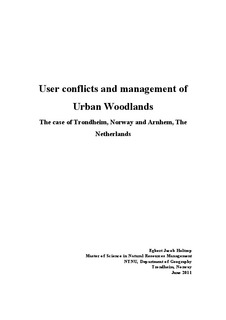| dc.contributor.advisor | Aasetre, Jørund | nb_NO |
| dc.contributor.author | Holtrop, Egbert Jacob | nb_NO |
| dc.date.accessioned | 2014-12-19T14:26:00Z | |
| dc.date.available | 2014-12-19T14:26:00Z | |
| dc.date.created | 2012-08-01 | nb_NO |
| dc.date.issued | 2011 | nb_NO |
| dc.identifier | 542514 | nb_NO |
| dc.identifier.uri | http://hdl.handle.net/11250/265381 | |
| dc.description.abstract | Urban woodlands are forests in and around cities that are used intensively for recreation and as such can be sites of conflicts between various users and uses. The aim of this research is to compare the recreational situation and management context in two areas: Arnhem in The Netherlands and Trondheim in Norway. The cases represent opposide ends of the scale when it comes to population density and availability of urban woodlands
The study used different methods to describe the situation in the two case areas. Interviews were carried out to uncover management practises and challenges in the case areas. Selfregistration questionnaires gathered information about the actual recreational use, preferences and conflicts and document studies were use to describe the policies and laws in the countries and municipalities.
The study shows that the freedom to roam is an important aspect in Norwegian law and policy. There is a common right to access and passage of uncultivated lands, and outdoor recreation is an integrated part of national policies, including environmental protection policies. The Netherlands do not have the right to free access of uncultivated land, property right are more dominant and recreational access is only allowed when permission is granted. This permission is common but with strict rules as to when, what and where different activities can be practised.
Interviews showed that the laws and policies are for the large part appreciated by the representatives of the interest groups that were interviewed. The Dutch interviewees accepted restrictions because they felt that it protects nature and prevents conflicts. The Norwegian interviewees mentioned that there were some conflicts but accepted them because everybody should have the freedom to go anywhere. Zoning was an option but only as an encouragement, not as a coercive force.
A questionnaire was carried out to investigate the level of conflicts among people using the area. This questionnaire was based on convenient sampling and is not representative for all visitors of urban woodlands or the case areas. The respondents did not show a difference in what they recognize as actual conflicts. It did show, however, a difference in attitude towards other users. The most striking difference was the difference in the scores of the purism scale. Dutch respondents had a much more purist attitude than Norwegian respondents, and this difference was found to be predominantly explained by nationality.
More intense use of urban woodlands and a wider variety of uses ask for a stricter management regime to protect the interests that are represented in urban woodlands. The question is if, in a context of the ‘freedom to roam’, there is an instrument that can protect those interests when there is a strong user pressure by a variety of activities. | nb_NO |
| dc.language | eng | nb_NO |
| dc.publisher | Norges teknisk-naturvitenskapelige universitet, Fakultet for samfunnsvitenskap og teknologiledelse, Geografisk institutt | nb_NO |
| dc.title | User conflicts and management of Urban Woodlands: The case of Trondheim, Norway and Arnhem, The Netherlands | nb_NO |
| dc.type | Master thesis | nb_NO |
| dc.contributor.department | Norges teknisk-naturvitenskapelige universitet, Fakultet for samfunnsvitenskap og teknologiledelse, Geografisk institutt | nb_NO |
